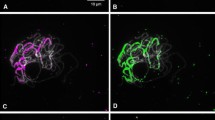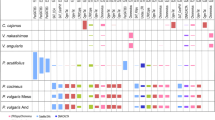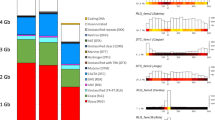Abstract
Isolation and characterization of the most prominent repetitive element families in the genome of tetraploid cotton (Gossypium barbadense L; [39]) revealed a small subset of families that showed very different properties in tetraploids than in their diploid progenitors, separated by 1-2 million years. One element, B77, was characterized in detail, and compared to the well-conserved 5S and 45S rRNA genes. The 572 bp B77 repeat was found to be concentrated in several discontinuous tandem arrays confined to a single 550 kb SalI fragment in tetraploid cotton. Genetic mapping based on the absence of the pentameric ‘rung’ in the G. barbadense ‘ladder’ showed that B77 maps to a D-subgenome chromosome. In situ hybridization supports the contention that the array is confined largely to a single chromosomal site in the D-subgenome. The B77 repeat has undergone a substantial increase in copy number since formation of tetraploid cotton from its diploid relatives. RFLPs observed among tetraploid cotton species suggest that amplification and/or rearrangement of the repeat may have continued after divergence of the five tetraploid cotton species. B77 contains many short direct repeats and shares significant DNA sequence homology with a Nicotiana alata retrotransposon Tna1-2 integrase motif. The recent amplification of B77 on linkage group D04 suggests that the D-subgenome of tetraploid cotton may be subject to different evolutionary constraints than the D-genome diploid chromosomes, which exhibit few genome-specific elements. Further, the abundance of B77 in G. gossypioides supports independent evidence that it may be the closest extant relative of the D-genome ancestor of cotton.
Similar content being viewed by others
References
Arumuganathan K, Martin GB, Telenius H, Tanksley SD, Earle ED: Chromosome 2-specific DNA clones from flowsorted chromosomes of tomato. Mol Gen Genet 242: 551–558 (1994).
Awgulewitsch A, Bunemann H: Isolation of Y-chromosomal repetitive DNA sequences of Drosophila hydei via enrichment of chromosome-specific sequences by heterogeneous hybridization between female and male DNA. J Biochem Biophys Meth 12: 37–50 (1986).
Beasley JO: Meiotic chromosome behavior in species hybrids, haploids, and induced polyploids ofGossypium. Genetics 27: 25–54 (1942).
Burk RD, Stamberg J, Young KE, Smith KD: Use of repetitive DNA for diagnosis of chromosomal rearrangements. Hum Genet 64: 339–342 (1983).
Chittenden LM, Schertz KF, Lin Y-R, Wing RA, Paterson AH: A detailed RFLP map of Sorghum bicolor × S. propinquum suitable for high-density mapping suggests ancestral duplication of chromosome or chromosomal segments. Theor Appl Genet 87: 925–933 (1994).
Crane CF, Price HJ, Stelly DM, Czeshin DG: Identification of a homoeologous chromosome pair by in situ DNA hybridization to ribosomal RNA loci in meiotic chromosomes of cotton (Gossypium hirsutum). Genome 35: 1015–1022 (1993).
Cronn EC, Zhao X, Paterson AH, Wendel JF: Polymorphism and concerted evolution in a tandemly repeated gene family: 5S ribosomal DNA in diploid and allopolyploid cottons. J Mol Evol 42: 685–705 (1996).
Disteche C, Luthy D, Haslam DB, Hoar D: Prenatal identification of a deleted Y chromosome by cytogenetics and a Y-specific repetitive DNA probe. Hum Genet 67: 222–224 (1984).
Edwards GA, Endrizzi JE: Cell size, nuclear size, and DNA content relationships in Gossypium. Can J Genet Cytol 17: 181–186 (1976).
Endrizzi JE, Turcotte RJ, Kohel RJ: Qualitative genetics, cytology, and cytogenetics. ASA/CSSA/SSSA Publishers, Madison, WI (1984).
Endrizzi JE, Turcotte RJ, Kohel RJ: Genetics, cytology, and evolution of Gossypium. Adv Genet 23: 271–375 (1985).
Feinberg AP, Vogelstein B: A technique for radiolabeling DNA restriction endonuclease fragments to high specific activity. Anal Biochem 132: 6–13 (1983).
Fryxell PA: A revised taxonomic interpretation of Gossypium L. (Malvaceae). Rheedea 2: 108–165 (1992).
Fryxell PA: The natural history of the cotton tribe. Texas A & M University Press, College Station, TX (1979).
Ganal MW, Broun P, Tanksley SD: Genetic mapping of tandemly repeated telomeric DNA sequences in tomato (Lycopersicon esculentum). Genomics 14: 444–448 (1992).
Hall KJ, Parker JS, Ellis THN: The relationship between genetic and cytogenetic map of pea. I. Standard and translocation karyotypes. Genome 40: 744–754 (1997).
Hall KJ, Parker JS, Ellis THN, Turner T, Knox MR, Hofer JMI, Lu J, Ferrandiz C, Hunter PJ, Taylor JD, Baird K: The relationship between genetic and cytogenetic map of pea. II. Physical maps of linkage mapping populations. Genome 40: 755–769 (1997).
Hanson RE, Islam-Faridi MN, Percival EA, Crane CF, Ji Y, McKnight TD, Stelly DM, Price HJ: Distributions of 5S and 18S-28S rDNA loci in a tetraploid cotton (Gossypium hirsutum L.) and its putative diploid ancestors. Chromosoma 105: 55–61 (1996).
Heslop-Harrison JS, Harrison GE, Leitch IJ: Reprobing of DNA:DNA in situ hybridization preparations. Technical Tips 8: 372–373 (1992).
Islam-Faridi MN, Mujeeb-Kazi A: Visualization of Secale cereale DNA in wheat germplasm by fluorescent in situ hybridization. Theor Appl Genet 90: 595–600 (1995).
Jewell DC, Islam-Faridi MN: Details of a technique for somatic chromosome preparation and C-banding of maize. In: Freeling M, Walbot W (eds) The Maize Handbook, pp. 484–493. Springer-Verlag, New York (1994).
Kimber G: Basis of the diploid-like meiotic behavior of polyploid cotton. Nature 191: 98–99 (1961).
Kohler MR, Vogt PH: Interstitial deletions of repetitive DNA blocks in dicentric human Y chromosomes. Chromosoma 103: 324–330 (1994).
Nickrent DL, Soltis DE: A comparision of angiosperm phylogenies from nuclear 18S rRNA and rbcL sequences. Ann MO Bot Gard 82: 208–234 (1995).
Nishioka Y, Dolan BM, Zahed L: Molecular characterization of a mouse Y chromosomal repetitive sequence amplified in distantly related species in the genus Mus. Genome 36: 588–593 (1993).
Nishioka Y, Lamothe E: Isolation and characterization of a mouse Y chromosomal repetitive sequence. Genetics 113: 417–432 (1986).
Nishioka Y, Lamothe E: Isolation of human Y chromosomal major repetitive sequences from a flow-sorted Y chromosomal library. Am J Med Genet 27: 711–717 (1987).
Paterson AH, Brubaker CL, Wendel JF: A rapid method for extraction of cotton (Gossypium spp.) genomic DNA suitable for RFLP or PCR analysis. Plant Mol Biol Rep 11: 122–127 (1993).
Reinisch AJ, Dong J-M, Brubaker CL, Stelly DM, Wendel JF, Paterson AH: A detailed RFLP map of cotton, Gossypium hirsutum × Gossypiumbarbadens: chromosome organization and evolution in a disomic polyploid genome. Genetics 138: 829–847 (1994).
Roder MS, Lapitan NL, Sorrells ME, Tanksley SD: Genetic and physical mapping of barley telomeres. Mol Gen Genet 238: 294–303 (1993).
Royo J, Nass N, Matton DP, Okamoto S, Clarke AE, Newbigin E: A retrotransposon-like sequence linked to the S-locus of Nicotiana alata is expressed in styles in response to touch. Mol Gen Genet 250: 180–188 (1996).
Sanger F, Nicklen S, Coulson AR: DNA sequencing with chain-terminating inhibitors. Proc Natl Acad Sci USA 74: 5363–5367 (1977).
Stallings RL, Whitmore SA, Doggett NA, Callen DF: Refined physical mapping of chromosome 16-specific low-abundance repetitive DNA sequences. Cytogenet Cell Genet 63: 97–101 (1993).
Wendel JF: New World cottons contain Old World cytoplasm. Proc Natl Acad Sci USA 86: 4132–4136 (1989).
Wendel JF, Albert VA: Phylogenetis of the cotton genus (Gossypium): character-state weighted parsimony analysis of chloroplast-DNA restriction site data and its systematic and biogeographic implications. Syst Bot 17: 115–143 (1992).
Wendel JF, Schnabel A, Seelanan T: Bi-directional interlocus concerted evolution following allopolyploid speciation in cotton (Gossypium). Proc Natl Acad Sci USA 92: 280–284 (1995).
Wendel JF, Schnabel A, Seelanan T: An unusual ribosomal DNA sequence from Gossypium gossypioides reveals ancient, cryptic, intergenomic introgression. Mol Phyl Evol 4: 298–313 (1995).
Wu KS, Tanksley SD: Genetic and physical mapping of telomeres and macrosatellites of rice. Plant Mol Biol 22: 861–872 (1993).
Zhao X, Wing RA, Paterson AH: Cloning and characterization of the majority of repetitive DNA in cotton (Gossypium L.). Genome 38: 1177–1188 (1995).
Zhao X, Wu T, Xie Y, Wu R: Genome-specific repetitive sequences in the genus Oryza. Theor Appl Genet 78: 201–209 (1989).
Zhao X, Zhang H-B, Wing RA, Paterson AH: A simple method for isolation of megabase DNA from cotton. Plant Mol Biol Rep 12: 110–115 (1994).
Zhao X, Si Y, Hansen RE, Crane CF, Rice HJ, Stelly DM, Wendel JF, Paterson AH: Dispersed repetative DNA has spread to new genomes in cotton. Genome Res 8: 479–492 (1998).
Author information
Authors and Affiliations
Rights and permissions
About this article
Cite this article
Zhao, X., Ji, Y., Ding, X. et al. Macromolecular organization and genetic mapping of a rapidly evolving chromosome-specific tandem repeat family (B77) in cotton (Gossypium). Plant Mol Biol 38, 1031–1041 (1998). https://doi.org/10.1023/A:1006073116627
Issue Date:
DOI: https://doi.org/10.1023/A:1006073116627




